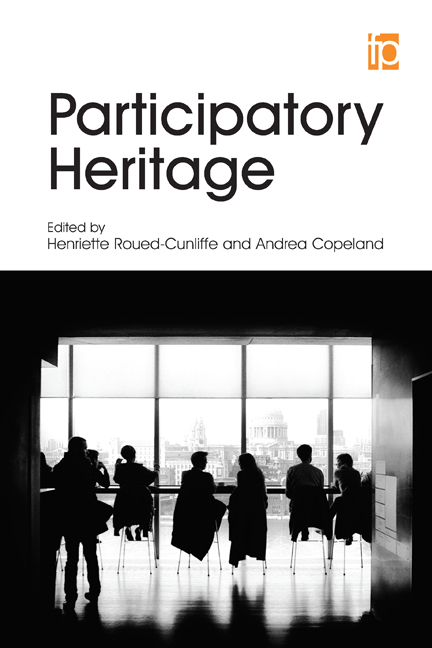Book contents
- Frontmatter
- Contents
- List of figures and tables
- Contributors
- Introduction: what is participatory heritage?
- Part 1 Participants
- 1 A communal rock: sustaining a community archives in Flat Rock, Georgia
- 2 The Bethel AME Church Archive: partners and participants
- 3 Creating an authentic learning environment for school children: a case study of digital storytelling programmes at the Mudgeeraba Light Horse Museum
- 4 Viking re-enactment
- 5 Learning, loving and living at the Australian Country Music Hall of Fame
- 6 The contributions of family and local historians to British history online
- 7 Forgotten history on Wikipedia
- Part 2 Challenges
- Part 3 Solutions
- Further reading
- Index
4 - Viking re-enactment
from Part 1 - Participants
Published online by Cambridge University Press: 08 June 2018
- Frontmatter
- Contents
- List of figures and tables
- Contributors
- Introduction: what is participatory heritage?
- Part 1 Participants
- 1 A communal rock: sustaining a community archives in Flat Rock, Georgia
- 2 The Bethel AME Church Archive: partners and participants
- 3 Creating an authentic learning environment for school children: a case study of digital storytelling programmes at the Mudgeeraba Light Horse Museum
- 4 Viking re-enactment
- 5 Learning, loving and living at the Australian Country Music Hall of Fame
- 6 The contributions of family and local historians to British history online
- 7 Forgotten history on Wikipedia
- Part 2 Challenges
- Part 3 Solutions
- Further reading
- Index
Summary
THE YEAR 1977 was when Voyager I left Earth to go on a long journey, visiting other planets. It was also the year of the first Star Wars movie. And in that same year the first Viking Moot at Moesgaard took place. Since its founding by Moesgaard Museum, the historical re-enactment has been held annually in Aarhus, Denmark. It is a mixture of a market place with Viking Age jewellery, clothes, weapons and food stands, Viking workshops and Viking re-enactment fighting groups. In 2015 the event attracted 1300 participants from a dozen countries and 14,000 visitors. Participation is a key part of this heritage event, whether through listening to music or storytelling, going into single-combat contests, performing mock battles or presenting the Icelandic cavalry. The challenge is one of finding the right balance between role-playing entertainment and educational experiences. On the one hand, a lot of people show up just to be entertained, and on the other hand, the organizers have an educational purpose in mind. The purpose of this chapter is to present Moesgaard Viking Moot as a participatory local heritage event with a diverse range of spectators and participants.
The Viking Moot at Moesgaard has mainly been documented in newspaper articles and a few academic articles. There is also archive material that is currently being stored by Sara Heil Jensen, whom I interview in this chapter.
Historical re-enactment
Re-enactment is not easily defined because it takes many forms. It is a lively study covering a wide range of customs and activities. One problem is that the term ‘historical re-enactment’ has been used to describe living history museums, technical reconstructions, literature, photography, film, video games, television shows, pageants, parades and even internet groups devoted to online historical performance (Agnew, 2007). This, however, is by far too broad a definition for understanding the concept of historical reenactment at Moesgaard Viking Moot. Here the co-ordinators and participants share a more or less faithfully reconstructed Viking world for a week. This is much closer to what Gary Alan Fine calls a collectively shared fantasy, much as in a role-playing game (Fine, 2002). But, unlike in a role-playing game, it is not meant as a fictional story-world and the participants do not necessarily assume a role – although this may happen.
- Type
- Chapter
- Information
- Participatory Heritage , pp. 37 - 46Publisher: FacetPrint publication year: 2017



